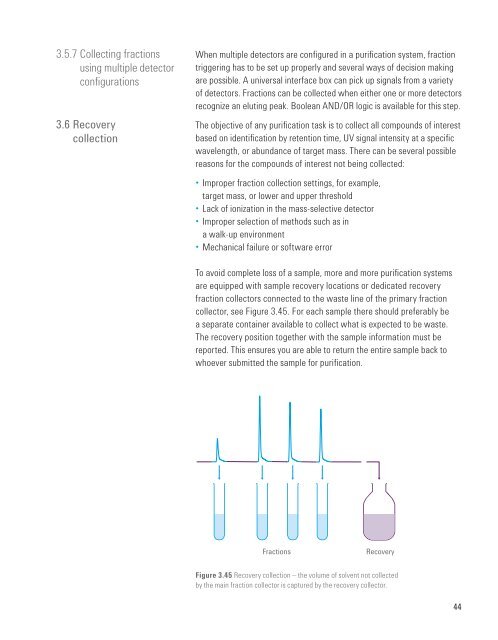Principles and Practical Aspects of Preparative Liquid Chromatography
You also want an ePaper? Increase the reach of your titles
YUMPU automatically turns print PDFs into web optimized ePapers that Google loves.
3.5.7 Collecting fractions<br />
using multiple detector<br />
configurations<br />
3.6 Recovery<br />
collection<br />
When multiple detectors are configured in a purification system, fraction<br />
triggering has to be set up properly <strong>and</strong> several ways <strong>of</strong> decision making<br />
are possible. A universal interface box can pick up signals from a variety<br />
<strong>of</strong> detectors. Fractions can be collected when either one or more detectors<br />
recognize an eluting peak. Boolean AND/OR logic is available for this step.<br />
The objective <strong>of</strong> any purification task is to collect all compounds <strong>of</strong> interest<br />
based on identification by retention time, UV signal intensity at a specific<br />
wavelength, or abundance <strong>of</strong> target mass. There can be several possible<br />
reasons for the compounds <strong>of</strong> interest not being collected:<br />
• Improper fraction collection settings, for example,<br />
target mass, or lower <strong>and</strong> upper threshold<br />
• Lack <strong>of</strong> ionization in the mass-selective detector<br />
• Improper selection <strong>of</strong> methods such as in<br />
a walk-up environment<br />
• Mechanical failure or s<strong>of</strong>tware error<br />
To avoid complete loss <strong>of</strong> a sample, more <strong>and</strong> more purification systems<br />
are equipped with sample recovery locations or dedicated recovery<br />
fraction collectors connected to the waste line <strong>of</strong> the primary fraction<br />
collector, see Figure 3.45. For each sample there should preferably be<br />
a separate container available to collect what is expected to be waste.<br />
The recovery position together with the sample information must be<br />
reported. This ensures you are able to return the entire sample back to<br />
whoever submitted the sample for purification.<br />
Fractions<br />
Recovery<br />
Figure 3.45 Recovery collection – the volume <strong>of</strong> solvent not collected<br />
by the main fraction collector is captured by the recovery collector.<br />
44



